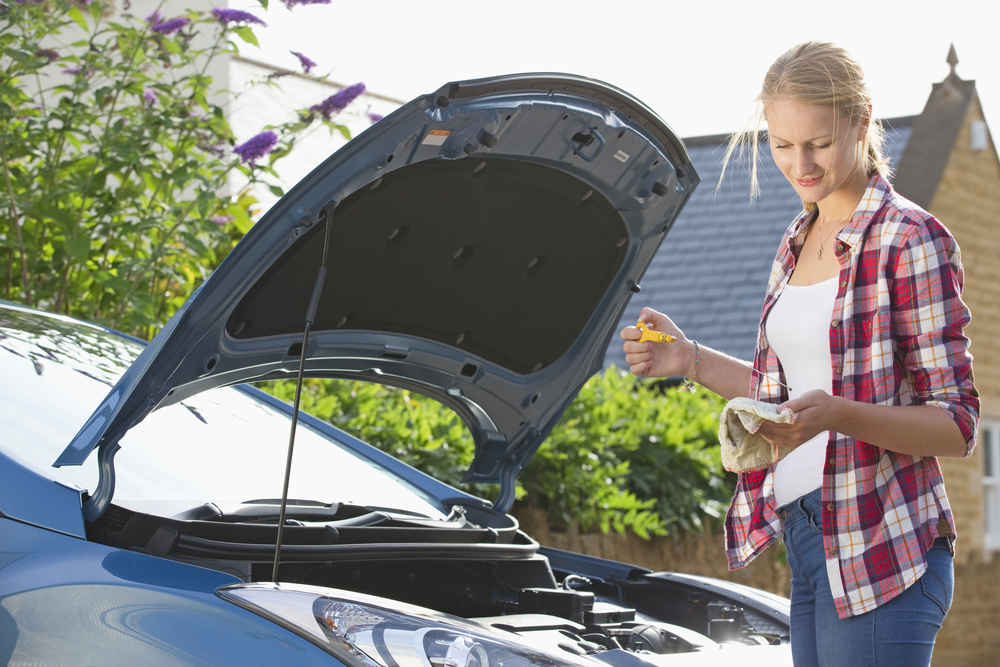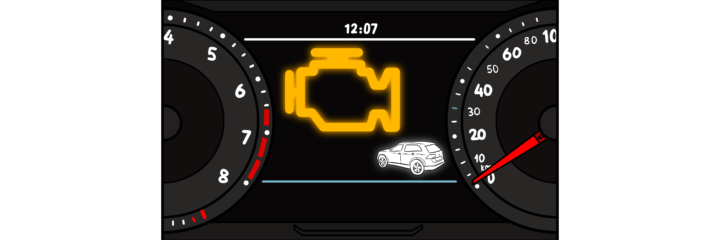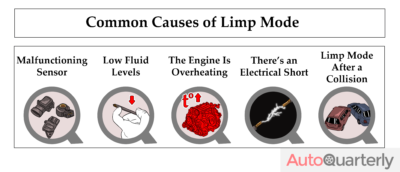Modern cars have a way of protecting themselves when things go wrong. It’s called “limp mode,” and if you have the misfortune of experiencing it, you might think your car is possessed. Not only will your dashboard light up with a variety of colorful flashing symbols, but it will feel like you are driving through Jell-O.
Don’t panic or hire an exorcist just yet. This article will explain what limp mode is and if it’s dangerous to your car. After that, we’ll talk about some of the most common causes and how to solve them.
What Is Limp Mode?
Cars manufactured after 1997 have an onboard diagnostic (OBD) computer that can automatically detect problems with the engine. Newer cars have even more advanced computers that control the engine, called powertrain control modules (PCMs) or engine control units (ECUs). When the diagnostic circuit detects a major fault, the PCM forces the engine into limp mode.
Limp mode is meant to protect your engine by only allowing the most basic systems to operate. Think of it like breaking your leg and having to limp home. You will be as careful as possible; you certainly wouldn’t try to run or jump. Your car will behave the same way.
Symptoms of Limp Mode
The specific symptoms that you experience will vary depending on your vehicle’s make and model. However, there are three main indicators that are almost always present.
Check Engine Light Is Illuminated
The check engine light lighting up is often the first sign that something is going wrong. When your car enters limp mode, the check engine light will probably flash, and so will other warning lights, like the oil pressure light or the battery light. This is the way your car’s computer can communicate to you, the driver, that you need to get to a mechanic.
Do note that the check engine light merely being on does not mean your car is limping. The check light will illuminate if the diagnostic circuit detects any fault, even the ones that are not dangerous at all. When the light flashes, though, it’s usually an indicator of a more serious issue.
The Car’s Performance Is Suffering Greatly
The most noticeable symptom of limp mode is that your car will perform terribly. Like we said above, this is to prevent you from running on a broken leg. You will notice that the car won’t go over 40mph, no matter how hard you press the gas, and it takes a very long time to get to 40. In fact, since the RPMs will be severely limited, you may not even make it to 40, so be careful when trying to get out of traffic.
You will also notice that the transmission won’t shift. The PCM will often choose what it believes is the safest gear, and it won’t allow you to change it.
Many Systems Will Not Operate
If your car enters limp mode, and it’s a newer car, it may shut off all non-essential systems. That can include your radio and air-conditioner. Limp mode can also disable drive modes. For instance, you may not be able to enter 4WD mode or sport mode.
Usually, these issues are annoying, but they rarely present a safety hazard. However, you may find that what you consider “essential” and what your car considers essential are different. That’s why it’s important to have emergency supplies in your car, like water and a blanket. A short journey can become a very long journey without any climate controls.
Is Limp Mode Dangerous?
Limp mode by itself is not dangerous to your car. Unfortunately, it usually means something bad has already happened. The only thing limp mode is meant to do is to get you home —or to a mechanic so that you can get the problem fixed.
Limp mode can put you into a dangerous situation, however. If your car enters limp mode on the highway, for instance, then you may not be able to keep up with the flow of traffic, and you should pull over and call a tow truck.
When to Stop Driving in Limp Mode
While limp mode is not dangerous by itself, there are other things that can cause serious damage to your car that can trigger limp mode. If you notice the following issues with your car, pull over and have your car towed instead.
- You hear loud knocking.
- There is white smoke coming from your tailpipe.
- Your car is overheating.
- There are harsh vibrations that make it difficult to drive.
The Risk of Overheating
Some cars are prone to overheating while in limp mode, so keep an eye on the temperature gauge. Overheating the engine can make a bad situation much worse.
This is mostly a risk that older vehicles have because the fan and radiator are tied directly to the RPMs. When the RPMs can’t advance because the car is in limp mode, the radiator can’t work as well, and the car will begin to overheat.
Common Causes
There are a lot of different reasons a car will enter limp mode. Almost anything that affects the transmission, fuel delivery, or ignition timing can cause the PCM to force the car to limp.
The following causes are simply four of the most common issues that can force your car into limp mode. They represent a good place to start if you are diagnosing your own car. Don’t forget to check for codes first using an OBD2 scanner, like the ones we recommend.
Malfunctioning Sensor
There are many sensors under your hood that monitor your engine’s health, such as the manifold absolute pressure (MAP) and mass airflow (MAF) sensors that measure the airflow, as well as the knock-sensor that detects pre-detonation. If these sensors fail, they can cause your engine to run poorly.
If the engine begins to run so poorly that you begin to risk damaging internal components, you will likely enter limp mode. MAF sensors are particularly prone to fouling. They can compound other issues if they get dirty and stop functioning.
Low Fluid Levels
Modern cars often have sensors that detect the transmission fluid level, the oil level, and the coolant level. A car may enter limp mode if one of the essential fluids is low enough that there is a risk to the health of the motor.
Low transmission fluid levels can damage your transmission if it needs to shift or rotates too quickly. A low oil level can cause the engine to overheat, and you will risk damaging internal components, like piston rings and crank bearings. Low coolant levels will lead to overheating.
The Engine Is Overheating
Anytime the engine runs hotter than normal, you risk entering limp mode. We already mentioned low fluids as a reason a car may overheat, but head gasket problems, fan issues, and a faulty thermostat can also cause a car to overheat.
There’s an Electrical Short
Electrical shorts and other electrical issues can cause limp mode. Usually, the electrical issue has to be somewhat serious for limp mode to occur. A short, for instance, may cause multiple systems to fail because it can cause ground issues for a variety of components.
Other, bigger electrical issues include a failing alternator, a disconnected or damaged ECU harness, or a disconnected ground strap. Electrical issues can be particularly difficult to diagnose, so if you suspect an issue, you may want to familiarize yourself with a multimeter. iFixit has an excellent guide here.
Limp Mode After a Collision
Your car will enter limp mode if you’ve been in a collision. It will remain in limp mode until you can clear the fault codes caused by the collision sensors. This is to give you time to check all your car systems and make sure there is nothing damaged.
Try These Fixes First

If your car is in limp mode, you can try these three things first.
Turn the Car off, Then Turn It On
Your car uses a computer to do all the engine calculations, and problems with your car’s computer can sometimes be solved the same way you’d solve problems with your home computer.
This can work because sometimes a sensor will detect a momentary problem, like a low fuel pressure sensor detecting low fuel pressure due to a bubble in the fuel line. Your car will enter limp mode, assuming that there is a serious problem, but the truth is that there isn’t anything wrong. By turning the car off, counting to ten, and then turning it back on, you are forcing the car to re-run the diagnostics.
Check All Your Fluids
Since low fluid levels are a common reason a car will enter limp mode, checking and filling your fluids can solve the issue. An automatic transmission is especially prone to having these issues, so if you have an automatic transmission, double-checking your transmission fluid level should be your first step.
Use an OBD2 Scanner
There are two things you can do with an OBD2 tool that will help. First, you can clear any stored faults and see if that solves the problem. Some older automotive computers are programmed to enter limp mode no matter what, and clearing the code can at least get you driving normally until the fault code returns.
The second thing scanning the computer might do is simply tell you exactly what you need to fix to get back on the road. If it’s something simple, like a disconnected or burned wire you can repair in a parking lot, you may be able to get back on the road quickly.
Get to a Mechanic
Even though it might feel like the car is broken, limp mode will protect your vehicle from costly damage. It’s so you can limp your car to a mechanic’s shop so they can fix the problem before it gets worse, or get back home, if you are your own mechanic. Be patient, drive carefully, bring your mechanic a drink from Starbucks, and you’ll be back on the road in no time.



